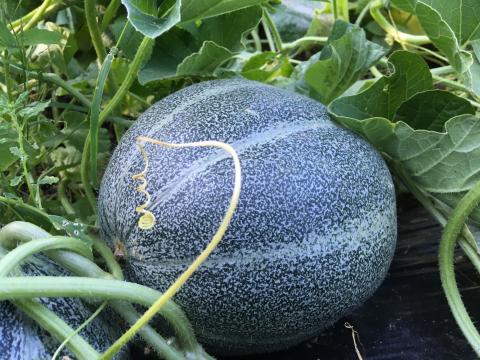Growing melons in New Hampshire

Given that a vine-ripened cantaloupe (muskmelon) is one of the most divine treats of summer, it is surprising that few northern New England gardeners grow them. After a couple of unsuccessful attempts, many have decided that they do not have the right soil to grow melons well or that they are otherwise tricky.
Melon varieties that we grow commonly fall into five classes: western and eastern muskmelons, honeydew, galia, and Charentais. In the descriptions below, netting is the network of corky lines that cover the rind, and sutures are the green lines that divide the rind into sections.
Western muskmelon– orange flesh, small oval fruit, tan skin that is coarsely netted, no sutures
Eastern muskmelon –orange flesh, large round fruit, tan skin with variable netting, with sutures
Honeydew –green/creamy flesh, light green smooth skin with no netting, no sutures
Galia (tropical) – green flesh, tan skin with netting, no sutures
Charentais (French) – orange flesh, green skin with no sutures and no netting
Several years ago, when I was collaborating with UMaine Cooperative Extension Vegetable Specialist Mark Hutton to evaluate different short-season muskmelon varieties, I asked Dr. Brent Loy for his advice on how to successfully grow melons in our climate. For over fifty years, Brent was a plant breeder at UNH who developed many of the melon varieties that are now considered standards. He focused on outstanding flavor and performance in Northern climates. Brent grew countless melon crops in recent decades, and he had developed an eight-step program aimed at market gardeners who want to successfully grow melons in New Hampshire. I share these tips with you here.
1. Pick a good growing site; preferably well-drained soil and a southern exposure.
- Pick varieties adapted to New England.
Brent’s recommendations: Halona (a powdery mildew and fusarium resistant replacement for Earliqueen) or Sarah's Choice as early eastern muskmelon, Diplomat (a powdery mildew replacement for Passport) for a galia type, and perhaps Maverick for a midseason eastern muskmelon.
I would also suggest picking smaller-fruited varieties. Many people feel intimidated by a 7 lb melon. I would add to this list Sugar Cube, a western muskmelon that produces many very sweet 2 – 2.5 lb fruits relatively late in the season. Another one of Brent’s newer varieties, First Kiss, is another western muskmelon that produces relatively small fruit with phenomenal flavor, early in the season. While a bit more finicky, I also like Petit Gris de Rennes, an excellent Charentais type.
- Start transplants between May 10 to 14, and aim to transplant into the field at the end of May or June 1 – AFTER soil temps are consistently above 65 F.
The above is for Southern NH. In cooler parts of the state, you may need to wait until June 10 for soil temps to be 65F. Do not seed melons earlier than 3 weeks prior to transplanting out into the field; if the transplants are stressed, they will start flowering a setting fruit before establishing a big healthy plant which can support lots of fruit.
- Use raised beds and plastic mulch for soil warming. Black plastic is fine for the main season crop; use solar mulch (infra-red transmitting or IRT) for the earliest crop or in the coldest sites.
- Use rowcovers for early season crop in Southern NH and even for main season crop in cooler areas.
The rowcover has two purposes: 1) to raise temperature slightly for early season growth and 2) to protect young transplants from cucumber beetles. Rowcovers do not need to be heavy; a lightweight (0.45 oz per square yard) fabric will work well for these purposes. Rowcovers must be removed once the plants start to set female flowers, so that bees can pollinate the flowers and set fruit.
- Use moderately high nitrogen levels to encourage fast and extensive canopy cover prior to fruit set.
Melons need 130 lbs of nitrogen and 200 lbs of potash per acre; they are moderately heavy feeders – this is roughly equivalent to the amount of fertilizer that a crop of sweet corn needs. Lack of fertility and water compromises the plants’ ability to support the fruit they set. Also, remember that weeds steal nitrogen and water; keeping the weeds at bay is critical.
- Pick melons at “force slip”. This means that you need to use moderate force with your thumb to loosen fruit.
If you wait until melons slip off easily (full slip), they continue to ripen off the vine and may become overripe within a day or two. This is ok if you are eating them right as you pick them, but is problematic if you want to store them for a couple of days first.
Note: Charentais and honeydew types need to be harvested before they slip easily from the vine: they should be cut from the vine: follow variety-specific guidance to figure out when these are mature.
- This one is for market gardeners specifically: Advertise your melons appropriately. One option: Vine-ripened, high-sugar melons developed at UNH for local New England production. Think about giving small samples to customers.
You can find other helpful melon production tips such as plant spacing and pest management info in the New England Vegetable Management Guide, http://www.nevegetable.org, under ‘cucumber, muskmelon and watermelon’.
Thanks to Dr. Brent Loy, University of New Hampshire, for his advice. Beyond that, I am grateful for his decades of work developing outstanding melon varieties that perform well for us Northern gardeners.
Learn more about growing melons by watching this video.
